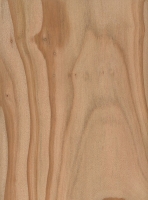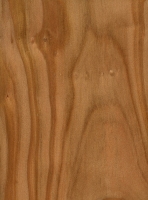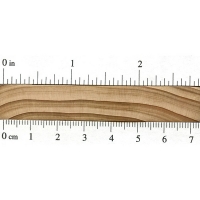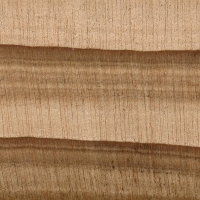 |
Common Name(s): Sugi, Japanese Cedar Scientific Name: Cryptomeria japonica Distribution: Endemic to Japan; commonly grown on plantations within Asia Tree Size: 100-165 ft (30-50 m) tall, 6-10 ft (2-3 m) trunk diameter Average Dried Weight: 23 lbs/ft3 (360 kg/m3) Specific Gravity (Basic, 12% MC): .33, .36 Janka Hardness: 320 lbf (1,420 N) Modulus of Rupture: 5,280 lbf/in2 (36.4 MPa) Elastic Modulus: 1,109,000 lbf/in2 (7.65 GPa) Crushing Strength: 4,060 lbf/in2 (28.0 MPa) Shrinkage: Radial: 2.1%, Tangential: 6.8%, Volumetric: 10.5%, T/R Ratio: 3.2 |
Color/Appearance: Heartwood is typically reddish brown. Sapwood is straw colored and clearly demarcated from the heartwood. Knots are common. Sometimes the wood is traditionally charred black (increasing its fire and rot resistance) using a Japanese technique known as shou sugi ban; such flame-treated planks are commonly used as siding.
Grain/Texture: Grain is straight; medium, even texture. Moderate natural luster.
Endgrain: Resin canals absent; earlywood to latewood transition fairly gradual, color contrast medium-high; tracheid diameter small-medium; diffuse parenchyma.
Rot Resistance: Rated as moderately durable to durable; moderate insect/borer resistance.
Workability: Generally easy to work with hand or machine tools, though knotty areas can be troublesome. Responds poorly to steam bending. Glues, stains, and finishes well.
Odor: Has a distinct, lingering, cedar-like odor.
Allergies/Toxicity: Sugi sawdust has been reported to cause unspecified allergic reactions. In addition to the wood, the pollen of the tree is also known to be highly allergenic in Japan. See the articles Wood Allergies and Toxicity and Wood Dust Safety for more information.
Pricing/Availability: Not widely imported, Sugi is generally available in Asia as siding or other light construction purposes, as well as veneer. Smaller craft lumber is sometimes imported and made available. Prices are in the mid range for an imported softwood.
Sustainability: This wood species is not listed in the CITES Appendices, but is reported by the IUCN as being near threatened. Technically it doesn’t meet the Red List criteria of a vulnerable or endangered species, but is close to qualifying and/or may qualify in the near future. Though the trees are extensively (and sustainably) grown on plantations, the natural stands where the tree grows are fragmented and small, and not easily distinguished from the plantations which grow the same species.
Common Uses: Siding, paneling, furniture, fences, boatbuilding, and small specialty items.
Comments: Sometimes called Japanese Cedar, the wood is in the Cupressaceae family, which includes many cedar-like species. Like most cedars, the wood is soft, light, aromatic, and resistant to decay. Sugi is a commercially important softwood species within Japan, and is commercially grown for many construction purposes.
According to legend, in the early 1600s there was a feudal lord in Japan who was too poor to donate a stone or bronze lantern at the funeral of the deceased shogun. Instead, he proposed to plant a row of trees along the avenue which led to the temple where the shogun was buried. These trees still line the path to the temple, and are considered some of the most stately and impressive displays of trees in all of Japan.
None available.
 |
 |
 |
 |





We were given a gift 50 years ago of a carved beaver by a Canadian artist Gerd Undermann. In seeing his work online most of them seem to use the term cryptomeria to describe the wood although some just use the generic cedar. Is there any way anyone could let me know if mine is likely to be cryptomeria? Thanks
Can Sugi be used as a substitute for Western Red Cedar for decking; with 16” on center framing and 1.5” thick sugi?
More information is necessary. Like, what exactly do you mean “as a substitute”? Does the inquiry imply that Western Red Cedar is considered(by you) to be an adequate, acceptable, or the ideal choice for such an application? If the structural ability or “safety” of [OP supplied lumber type and dimensions] to stage and support one to several co-occupants plus various furniture items for purposes of non- to semi-rigorous recreational/leisure activities is the reason for inquiry, I think you could walk on just about any lumber 16″oc @1.5″ thick at regular intervals(daily, hourly, biweekly, etc.) for regular durations(1 hour, 6 hours,… Read more »
Hello. Does this look like Sugi wood?
Thank you
I have a Snare Drum made by Tama made of this wood. They charred the out side, and the entire shell is steam bent.
Really? Interesting, up there the description says that this kind of wood doesn’t really like steam bending, weird. Personally, I’m not familiar with this snare, when did they make it? Is it like, somebody’s signature model or like a one off type series? How’s it sound?
It came out in 2023. It’s the Tama Star Reserve Vol. 9 14×6. It is very crispy and a little on the dry side, but they used the Starclassic Bell Bronze wires which makes it very lively. Great for hip hop, jazz and funk.
Wondering how this wood compares to WRC for a raised garden bed? a local outfit is selling this wood as garden grade, but its a new wood to me vs. the WRC which is touted as the go to for raised beds
hi, can I use Sugi for coorwood wall building?
Could you ever use Sugi cedar for siding on a house? Would you need to treat first?
https://www.shizenstyle.com/post/the-complete-guide-to-yakisugi-shou-sugi-ban-1
Hello! I am building a Sauna and was trying to find of Sugi would be a good as Western Red for the interior of the Sauna? Thanks for any help – Ali
Any cedar for the interior wood be a good choice. Dries quickly, soft wood that endures expansion and contraction from moisture variation, and it’s easy to work with .
Looking to build tabletops and counters for a small Japanese restaurant. I wanted to use a traditional Japanese wood. Would Sugi Pine be a good choice for this project t?
The wood is awfully soft, so you’d definitely be faced with a lot of dents and dings. Maybe you are going for a more rustic appearance, but in general, soft woods like this for tabletops isn’t preferred.
Thanks Eric. I might decide to use a bar top epoxy resin to protect it.
Can someone tell me if I can expect a Sugi bedframe I am making to substantially darken if I don’t apply a finish? Or I am considering using a clear shellac. The reason I ask is that my wife is not excited with the somewhat orange like hue, although she is delighted with the grains and contrasts.
Appreciate any input. Mahalo, Opi and Satu
You could always use wood bleach to lighten the color before applying a finish. I would still also avoid oil-based finishes as they might contribute to darkening over time.
I had a similar question- is this reliable material for fencing compared to western red cedar and are most japanese cedar fences similar or are there different levels of quality within the japanese cedar wood?
thanks
Hi Mike,
Can say for the western red cedar, but there is no “category” in the Sugi here in Japan. Just beware of the knotty areas. Otherwise that wood is surprisingly cheap and resistant wood.
Japanese cedar (or Japanese sugi) is actually a species of Cryptomeria, while western red cedar is a Thuja, both completely different genera. Red cedar has plicatic acid in it which makes it highly resistant to decay, while I cannot say the same about Japanese sugi, which is not that decay-resistant. Go with the red cedar! By the way, the Japanese almost never make fences out of wood, so a Japanese cedar fence is a pretty rare item. The Japanese might use treated Japanese cedar fence posts, although I have never seen any either (having lived 8 years in Japan, traveling… Read more »
It’s worth noting that the weird sugi is used as a marketing tool, most pickets that are sold as Japanese sugi are in fact western red cedar trees farmed in China. So yes, most sugi pickets are excellent for fences in America, but they are in fact Chinese cedar pickets…
is this particular cedar a good grade for fencing long term AND IS IT VERY DURABLE TO WEATHER CONDITIONS COMPARE TO WESTERN RED CEDAR